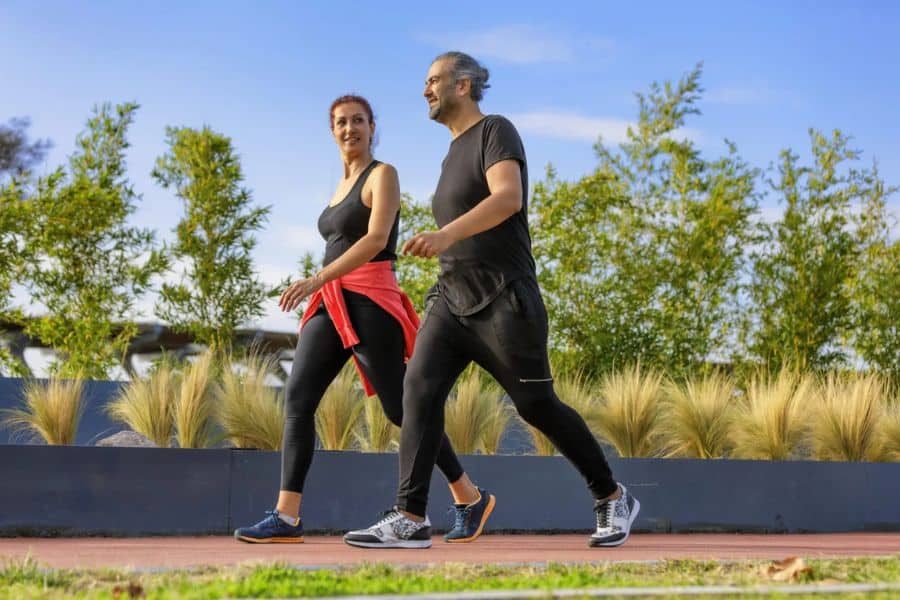Walking for Heart Health
Cardiovascular Benefits
Walking does wonders for your heart, making it one of the simplest yet powerful ways to keep your ticker in top shape. When you consistently hit the pavement, you’re knocking down those pesky risk factors for heart disease. As it turns out, walking isn’t just good, it’s crucial for living your best life. Check out what regular strolling can do for your heart:
- Boosts Heart Efficiency: A casual walk gives your heart a workout by getting that blood pumping like it should.
- Tames High Blood Pressure: Put the brakes on hypertension with a regular walking routine.
- Hypes Up Good Cholesterol: Walking not only increases the good stuff (HDL) but also kicks the bad stuff (LDL) to the curb.
- Shrinks Fat Rolls: Moving those feet helps you shed pounds and cut away those unwanted fat layers.
- Controls Blood Sugar: It’s like a natural sugar regulator for your body.
- Melts Away Stress: Give your mind a break with a mood-lifting walk.
To keep your heart happy, aim for about two and a half hours of brisk walking each week. That’s enough to make a real difference according to health experts.
| Health Benefit | Impact of Walking |
|---|---|
| Lowers Blood Pressure | Slashes hypertension levels |
| Cholesterol Magic | Pumps up HDL, squashes LDL |
| Weight Loss | Burns calories, trims fat |
| Sugar Control | Balances blood glucose |
| Stress Buster | Clears the mind, lightens the mood |
Age and Gender Considerations
No matter your age or gender, walking keeps your heart ticking strong. Big studies shout out its perks for folks from every walk of life, including young guns, mid-lifers, and the seasoned bunch, whether they’re fit or fighting some health battles (NCBI).
- Younger Adults: Start those healthy habits early to nip heart problems in the bud.
- Middle-Aged Adults: Stay in the game by keeping those numbers in check—weight, cholesterol, blood pressure.
- Older Adults: Walking can boost day-to-day living, help manage health issues, and keep those nasty falls at bay.
| Age Group | Benefits of Walking |
|---|---|
| Younger Adults | Forms healthy habits, heads off disease early |
| Middle-Aged Adults | Balances weight, pressure, cholesterol |
| Older Adults | Elevates quality of life, tackles health issues, fends off falls |
Whether you’re a dude or a gal, walking’s got your back. Men often keep an eagle eye on heart health, while women might zero in on keeping those scales and stress levels in check (PubMed Central).
Want to get started or amp up your walking game? Check out our tips on how to start a walking routine and up your steps with walking for weight loss.
Walking for Cardiovascular Disease Prevention
Primary and Secondary Prevention
Alright, let’s break it down – walking is like the unsung hero in keeping that ol’ ticker of yours ticking smoothly. Whether you’re keeping heart troubles at bay or managing things post-diagnosis, walking’s got your back (NCBI). To clear things up, primary prevention means stopping heart issues before they start, while secondary is about tackling them once they’ve already shown up at the party.
By taking strides regularly, you can knock down big risk factors of heart disease, like high blood pressure and those pesky high cholesterol levels. And get this – if you’re strolling to get places, voilà, you’ve just slashed your heart disease risk by a cool 11%.
| Benefits of Walking | Impact on Cardiovascular Health |
|---|---|
| Regular physical activity | Knocks down blood pressure |
| Active commuting | Slices heart disease risk by 11% |
| Consistent footsteps | Keeps cholesterol and triglycerides in check |
Prescription by Clinicians
Doctors these days ain’t just about those little pills. A stroll a day might just keep the doctor away! Physicians, like Dr. Hicham Skali from Mass General Brigham, are cheering on walking as a prime way to fend off heart worries, from high blood pressure to strokes.
When you pop in for a visit, they may help you sketch out some walking goals and maybe even suggest ways to make walking a part of your everyday shenanigans. They know that simply walking to the store or around the block can do wonders for stuff like cholesterol, blood pressure, and your body’s insulin game (NCBI).
If getting started feels like a chore, check out our walking workout plans or a walking routine for beginners. Don’t forget, warming up is key to dodging injuries when you’re trying something new.
Embracing the walking life isn’t just foolproof for your heart, it’s pretty easy on the knees too. Step into a new chapter of better heart health and embrace the active lifestyle you’ve been hearing about. Peek at our guides on how to start a walking routine and walking speed for cardio for some starting tips.
Tools for Promoting Walking
Want to get your heart pumping? Walking is your ticket, and with a few clever tools, you’ll be stride for stride with your health goals. Key aides include pedometers and some neat tricks for keeping walking a regular play in your week.
Pedometers and Step Goals
If you haven’t got a pedometer yet, you’re missing out! These nifty gadgets aren’t just there to admire; they keep tabs on your steps and give you the push you need to hit your targets. An activity tracker does the same but with a bit more flair — tracking distance and time, and sometimes even reminding you to get off that couch. Aiming for 3,000 steps in 30 minutes, five times a week? Just let a pedometer take the wheel!
| Tool | Function | Benefits |
|---|---|---|
| Pedometer | Counts steps taken | Keeps step goals in sight! |
| Activity Tracker | Charts steps, distance, and time | Keeps track of the nitty-gritty; boosts your drive |
| Walking App | Logs every walk and more | Watches over progress and helps set new targets |
| Walking Journal | Old-school logging | Lets you chew over progress and areas to amp up |
As Mayo Clinic puts it, recording your journey keeps motivation high. You can blend this info into either a digital or paper logbook, which might even come with goals, alerts, and snapshots of your achievements.
For those of you planning to take this a notch higher, our walking workout plans can be your next checkpoint.
Building Walking Habits
Getting a knack for walking isn’t rocket science. Start easy and ramp up as you get into the groove. Ease in slowly and see if you can reach 150 minutes of brisk walking per week, like the experts at American Heart Association News suggest.
Steps to Build a Walking Habit:
- Set Realistic Goals: Kick-off with short jaunts and stretch them over time.
- Schedule Walks: Make it a date; find your daily stride session.
- Buddy Up: A walk with a friend keeps the motivation ticking.
- Track Your Progress: That pedometer or app will be your cheerleader.
- Mix It Up: Spin the walking routes to bust boredom.
- Celebrate Successes: Give yourself a pat every time you smash a goal.
New to all this? Our walking routine for beginners might be the perfect starting point.
Whether it’s a pedometer or just some healthy walking habits, getting into the rhythm of walking can do wonders for your heart and how you feel overall. Curious about more ways to step up your walking game? Dive into our quirks and tips on indoor walking exercises and cardio walking pace.
Recommendations for Walking
Guidelines for Physical Activity
If you’re all about boosting heart health through walking, some good ol’ fashioned guidelines can help you get the most out of each step. So, here’s the lowdown: The American Heart Association thinks adults should aim for 150 minutes of easy-going walking or 75 minutes of more intense walking each week. They’ve even made it official. Mass General Brigham echoes these thoughts too.
To sprinkle a bit more clarity:
| Exercise Type | Recommended Time Per Week |
|---|---|
| Moderate-intensity walking | 150 minutes |
| Vigorous-intensity walking | 75 minutes |
If shedding a few pounds or just feeling fitter is your game, shoot for at least 30 minutes of moving around each day. So we’re talking 30 minutes of brisk walking, five days a week. Just starting out? Ease into it—no need to go full-throttle right away. We’ve got the scoop on how to ease into a walking routine if you’re curious.
Incremental Progress and Programs
Walking doesn’t have to be a big deal to make a big impact. Start with small walks, then gradually boost the time and speed. The peeps over at the Mayo Clinic think starting with 30 daily minutes is a good goal—break it up into smaller chunks if that’s more your speed.
Thinking about following a plan? Consider one with a little bit of everything:
| Week | Walking Duration (Minutes per Day) | Frequency (Days per Week) |
|---|---|---|
| 1 | 10-15 | 3-4 |
| 2 | 15-20 | 3-4 |
| 3 | 20-30 | 4-5 |
| 4 and beyond | 30+ | 5+ |
Don’t just focus on how long you’re walking, but how hard you’re walking too. Toss in some speedy walks or mix it up with interval training for that extra health kick. For tips, our walking workout plans have you covered.
Research is friendly to walkers, showing that sticking to moderate strolling helps your heart big time (NCBI). To be exact, about 8 hours of walking every week—think 30 mins a day for 5 days—can slash coronary heart disease risk by 19%.
Whether it’s about trimming down or turbocharging your ticker, regular walks could be your winning ticket. For weight-focused tips, peek into walking for weight loss or discover some indoor walking exercises for when the weather’s not playing nice.
If health stuff is making you nervous, chit-chat with your doctor before jumping into a new exercise vibe. For more pointers, check out our piece on walking routine for beginners. Lace up and start chasing that healthier heart with walking today!
Walking and Existing Heart Conditions
Let’s chat about how adding just a bit of walking into your daily routine can really boost heart health, especially if you’re dealing with heart conditions. Here, we’ll look into how walking strengthens your ticker and helps keep those pesky cardiac symptoms in check.
Strengthening the Heart Muscle
Rather than jumping into intense workouts, a leisurely walk can do wonders for your heart. It’s a simple exercise that’s not just easy on the joints but super effective for your heart health. Regular walks can fortify your heart muscle, get your blood pumping, and ramp up your overall cardiovascular health. Studies have shown that walking won’t mess with your heart condition, in fact, it does the exact opposite (Mass General Brigham).
Aside from working wonders on cholesterol levels and blood pressure, walking gives you that extra pep in your step (Abbott). Keeping a steady walking routine might even help dodge serious heart issues down the line.
Managing Cardiac Symptoms
Walking is like medicine for managing those heart bothers. If you often feel chest pain, fatigue, or breathless, a regular walk can smooth these out over time, easing your daily grind and making life more enjoyable.
Adding walking into your day not only brings stress down a notch but it gives your mood a nice little boost too! Physical activity kicks off endorphins, your body’s happy chemicals and natural pain busters (Abbott).
Experts have your back on this: walking can cut down your risk of heart disease and stroke—even if you’ve already got heart issues. Just two and a half hours of moderate strolls per week can do the trick (Abbott).
For more on spicing up your walking routine, have a look at our walking workout plans and walking routine for beginners. It’s all about starting easy and slowly picking up the pace till you match your fitness comfort zone.
| Benefits | Impact |
|---|---|
| Strengthens Heart Muscle | Pumps up blood flow and cardio fitness |
| Reduces Cardiac Symptoms | Lessens chest pain, tiredness, and hard breathing |
| Improves Cholesterol Levels | Slashes the chance of heart mishaps |
| Controls Blood Pressure | Keeps blood pressure stable |
| Boosts Mood | Dials down stress and ups overall happiness |
By setting aside a little time for walking each week, you can greatly boost your heart health and better manage any heart conditions. For a nudge on how to get going, check out our how to start a walking routine and see different walking speeds for cardio for top-notch health perks.
The Role of Walking Intensity
Brisk Walking vs. Leisurely Walking
Want to step up your heart health game with walking? It’s all about the pace. A regular brisk walk can work wonders for your ticker, helping to boost endurance and torch calories. The quicker and more often you stroll, the more you ramp up your aerobic benefits (Mayo Clinic).
Brisk walking is where you pick up the pace, ideally over 3 mph. It’s like giving your heart a little workout every time – lowering that blood pressure, cutting down cholesterol, and slashing diabetes risk. Studies have even linked brisk walking to a 24% reduced risk of mortality during a research period (American Heart Association News).
Leisurely walking, on the flip side, is more of a laid-back affair. Sure, going at about 2 mph still adds to your fitness, but it won’t give your heart as much of a workout. Yet, don’t underestimate the power of a gentle uphill walk—still packs a punch for your health.
| Walking Style | Speed | Health Perks |
|---|---|---|
| Brisk Walking | Above 3 mph | Cuts blood pressure, trims cholesterol, curbs diabetes risk |
| Leisurely Walking | Around 2 mph | General fitness, but fewer heart benefits |
Interval Training Considerations
For the ambitious, mixing brisk and leisurely walking can kick your cardio fitness into high gear, torching extra calories along the way (Mayo Clinic). It’s like making your heart do a little dance, keeping it engaged and the exercise fun.
How about brisk walk bursts? Try walking quickly for 3 minutes, then take a chill pill for 2 minutes, rinse and repeat. It’s a great way to get your heart in shape while keeping the routine from feeling like a drag.
Give interval walking a shot:
| Interval Type | Duration | Example |
|---|---|---|
| Brisk Walking | 3 minutes | Pick up the pace, over 3 mph |
| Leisurely Walking | 2 minutes | Slow down and enjoy |
Mix it up to get different muscles firing and keep your heart happy. For more ideas on spicing up your walks, peek at our guides on walking workout plans and how to start a walking routine. If you’re new, a walking routine for beginners can lay out a safe starting path.
Make your walks something you look forward to by switching up the pace. Get moving for a healthier heart, and for pacing tips, glance at our piece on walking speed for cardio.










